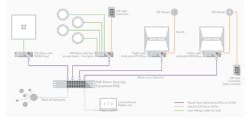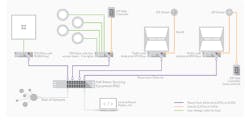Eaton has announced a joint offer of its LED luminaires combined with gateway modules, sensors, and control panels from NuLEDs that can together yield a Power over Ethernet (PoE) connected smart LED-based lighting system.
Eaton's lighting business (formerly Cooper Lighting) has announced a Power over Ethernet (PoE) collaboration with NuLEDs, a startup company focused on PoE and based in the San Diego, CA area. Both companies are part of Cisco's solid-state lighting (SSL)-centric Digital Ceiling initiative that is based around PoE. The partnership will enable Eaton to supply its PoE-enabled luminaires, and even standard LED-based lighting products, with NuLEDs SpiceBox modules/gateways, sensors, and control panels.
Interested in articles & announcements on PoE technology and connected SSL?
PoE has been in the news constantly of late. We just covered a new PoE project from Cree last week. For background on PoE technology used in lighting, review our last feature article on the topic. And we have covered Cisco's increased involvement in connected SSL technology which the company sees as a complement to its IT networking business.
NuLEDs was among the earliest players in the PoE lighting sector. In one of our first articles to mention PoE back in 2013, we covered a presentation that NuLEDs CEO Chris Isaacson made at Strategies in Light that year. That presentation marked among the first instances of public discussion revolving around PoE as a way to power and connect LED lighting.
The nearby illustration provides a glimpse as to how the Eaton and NuLEDs technologies may be used together. The SpiceBox modules are connected via PoE and serve to pass through power to luminaires either over Cat5/6 wiring or other low-voltage wiring. And the modules can control the power and connect to other smart lighting elements such as NuLEDs sensors and control panels. Each SpiceBox can control four individual LED lighting loads or the four channels can be used to control a red, green, blue, and white (RGBW) tunable fixture.
Eaton said it will supply the NuLEDs technology alongside products such as the Metalux Encounter troffer luminaire. In fact, the two companies have evidently already supplied two projects, although those details have not been made public yet.
"Our combined systems can meet virtually any design application where the customer desires a connected lighting solution utilizing a converged IT infrastructure in the building,” said Lisa Isaacson, co-founder and chief business development officer at NuLEDs.
Meanwhile, Eaton gains the ability to offer a complete connected SSL system. "Our collaboration with NuLEDs on the design and implementation of a complete lighting solution using PoE provides an essential link between LED light fixtures and the Internet of Things,” said Ken Walma, vice president and general manager of Eaton’s Lighting Division. "Together with NuLEDs’ system, building owners can gain flexibility and reduce costs, while benefitting from smart, connected lighting."
It is worth noting that PoE is not the only DC-centric power and interconnection technology that Eaton is pursuing. At LightFair International back in April, the company showed an internally developed platform called Distributed Low Voltage Power (DLVP).







